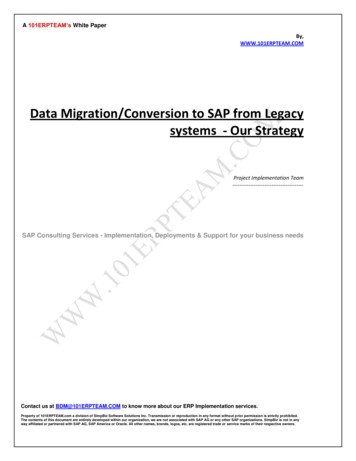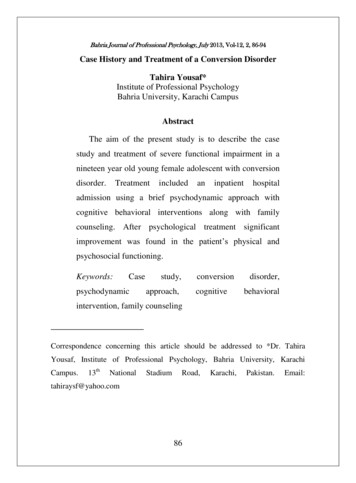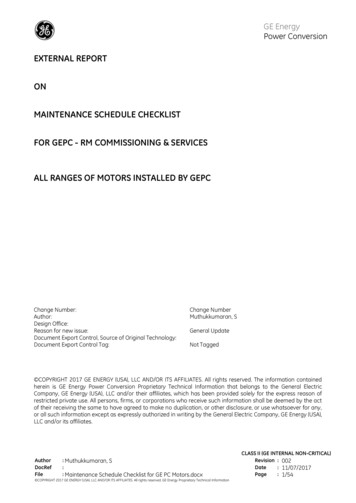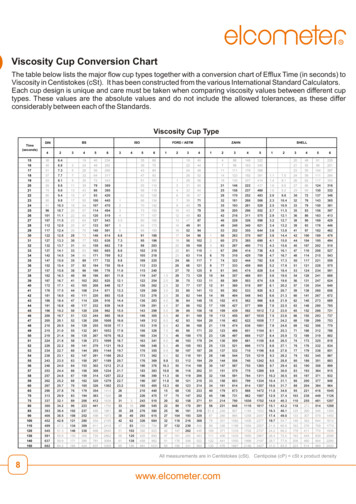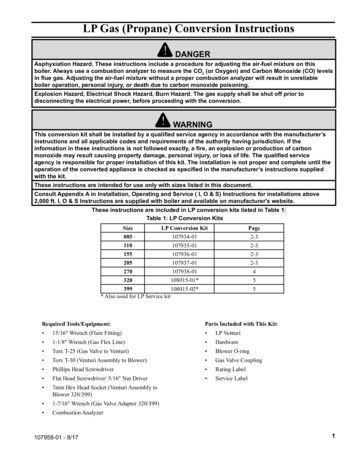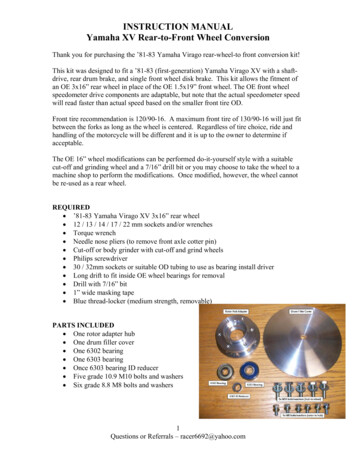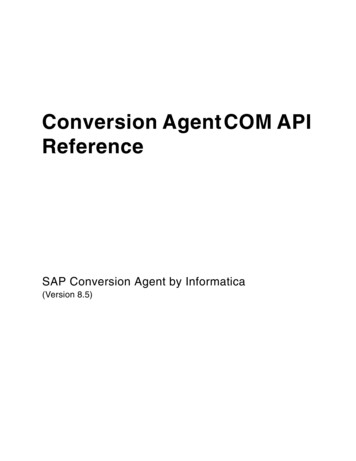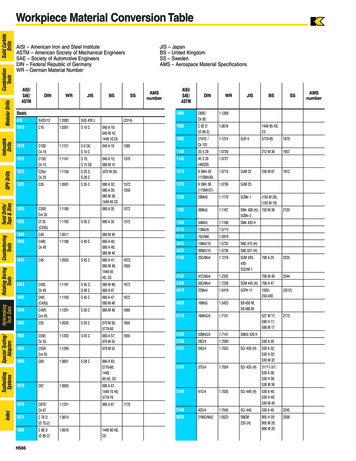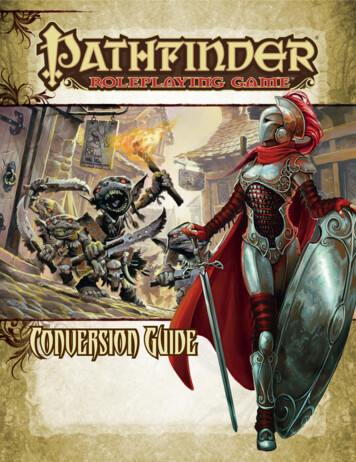
Transcription
Conversion Guide
Conversion GuideCreditsLead Designer: Jason BulmahnInterior Artists: Andrew Hou, Steve Prescott, Wayne Reynolds, and Eva WidermannEditor-in-Chief: James JacobsEditing and Development: Jason Bulmahn, Christopher Carey, Erik Mona,Sean K Reynolds, F. Wesley Schneider, Lisa Stevens, James L. Sutter, and Vic WertzEditorial Intern: Hank WoonArt Director: Sarah E. RobinsonSenior Art Director: James DavisLayout: Crystal FrasierPublisher: Erik MonaPaizo CEO: Lisa StevensVice President of Operations: Jeffrey AlvarezCorporate Accountant: Dave EricksonDirector of Sales: Pierce WattersSales Manager: Christopher SelfTechnical Director: Vic WertzEvents Manager: Joshua J. FrostBased on the original roleplaying game rules designed by Gary Gygax and Dave Arneson and inspired by the thirdedition of the game designed by Monte Cook, Jonathan Tweet, Skip Williams, Richard Baker, and Peter Adkison.Paizo Publishing, LLC7120 185th Ave NESte 120Redmond, WA 98052-0577paizo.comProduct Identity: The following items are hereby identif ied as Product Identity, as def ined in the Open Game License version 1.0a, Section 1(e),and are not Open Content: All trademarks, registered trademarks, proper names (characters, deities, etc.), dialogue, plots, storylines, locations,characters, artwork, and trade dress. (Elements that have previously been designated as Open Game Content or are in the public domain are notincluded in this declaration.)Open Content: Except for material designated as Product Identity (see above), the game mechanics of this Paizo Publishing game productare Open Game Content, as def ined in the Open Gaming License version 1.0a Section 1(d). No portion of this work other than the materialdesignated as Open Game Content may be reproduced in any form without written permission.Pathfinder Roleplaying Game Conversion Guide is published by Paizo Publishing, LLC under the Open Game License version 1.0a Copyright 2000Wizards of the Coast, Inc. Paizo Publishing, LLC, the Paizo golem logo, Pathf inder, and GameMastery are registered trademarks of PaizoPublishing, LLC; Pathf inder Roleplaying Game, Pathf inder Society, Pathf inder Chronicles, Pathf inder Modules, and Pathf inder Companionare trademarks of Paizo Publishing, LLC. 2009 Paizo Publishing, LLC.
Pathfinder RPG Conversion GuideThis guide is intended to make converting your 3.5 gameto the Pathfinder Roleplaying Game quick and easy.It includes rules for converting characters, monsters,feats, spells, prestige classes, and magic items from the 3.5version of the rules to the Pathfinder Roleplaying Game.To use this conversion guide, you will need a copy of thePathfinder Roleplaying Game Core Rulebook, as page numbersand tables referenced throughout this conversion guiderefer directly to that book. While the Pathfinder RoleplayingGame Bestiary (due out in September, 2009) is useful inconverting monsters, the guidelines in this document willsuffice until its release.The first half of this document addresses how to convertcharacters, covering everything from ability scores toexperience points. This step-by-step process is primarilyfor adjustments to player characters, but a quick version ispresented later for making changes to minor NPCs andvillains. The second half of this document deals withconverting existing mechanics, including prestige classes,feats, spells, and magic items. While this guide tackles a widevariety of issues, Game Masters should expect to adjudicate anumber of minor issues that fall outside this scope.Part 1: ConvertingCharactersConverting characters to the Pathf inder RPG is arelatively simple process. To perform the conversion of aplayer character, you should have a copy of the PathfinderRoleplaying Game Core Rulebook handly, as well as yourexisting 3.5 character, a Pathf inder RPG character sheet,and a pencil.Step 1: RaceRaces have seen a few changes from their 3.5 counterparts.Most of the races now receive two 2 bonuses to theirability scores and one –2 penalty. In addition, half-elves,half-orcs, and humans now all receive a single 2 bonus toan ability score of their choice (instead of their 3.5 bonusesand penalties). Table C–1 summarizes all of the changes tothe racial ability scores and gives the page number for eachrace. Note that these changes are in addition to the race’sexisting ability score modifiers, which have remainedunchanged. You should also check your character’s existingracial abilities against those granted by the PathfinderRPG and make the appropriate changes.Step 2: ClassOf all the changes, converting your class to the Pathf inderRPG requires the most work. Each of the 11 base classeshas received a number of changes, as summarized below.To convert your character, you should check these listsand make the appropriate adjustments for a character ofyour level. In most cases, this change is additive, meaningthat you will be adding new feats, not taking them away.If your character possesses levels in more than one baseclass, repeat this process for each one of your classes.Note that skills, feats, spells, hit points, and gear changesare handled in later steps and should be set aside for now.Barbarian (page 31)There are two large changes to the barbarian, the first beingan alteration to the way that rage is tracked, and the secondthe addition of rage powers. To convert your barbarian, takethe following steps. Rage is now tracked as a number of rounds per day, insteadof uses per day. Barbarians can rage for 4 rounds per day their Constitution modifier. This increases by 2 rounds perday for every level beyond 1st. The mechanics of rage itself( 4 Str, 4 Con, –2 AC, etc.) are unchanged. Starting at 2nd level, barbarians gain a rage power. Theseare special abilities that the barbarian can use whileraging. Barbarians gain one power at 2nd level and oneadditional power for every two levels beyond 2nd. Selectthe appropriate number of rage powers for your barbarianfrom the list of rage powers that begins on page 32 of thePathfinder Roleplaying Game Core Rulebook. Remove illiteracy from your barbarian. Enjoy books.Bard (page 34)The bard receives a number of changes and upgrades, thelargest of which involve its bardic performance (the new namefor bardic music) and its spell progression. The bard alsoreceives a few new abilities and additional bardic performancetypes. To convert your bard, take the following steps. Bardic Knowledge now grants a bonus to all Knowledgeskills equal to half your bard level (round down, minimum 1). This ability also allows you to use any Knowledge skilluntrained. This replaces the previous rules. Bardic Performance is now tracked as a number of roundsper day, instead of uses per day. Bards can use their bardicperformance ability for 4 rounds per day their Charismamodifier. This increases by 2 rounds per day for every levelbeyond 1st. Bards now receive a number of new performance types,and there have been some changes to existing performancetypes. Take a moment to reread all of the existingperformance types possessed by your character (startingon page 36). In addition, 1st-level bards now receive thedistraction performance type, 8th-level bards receivethe dirge of doom, 12th-level bards receive the soothingperformance, 14th-level bards receive frightening tune, and20th-level bards receive deadly performance. At 2nd level, the bard gains the versatile performance classfeature. This allows him to substitute his bonus in onetype of the Perform skill for his bonus in two other skills,depending on the type of Perform selected (see page 38).3
Table C–1: Racial Ability ScoreModificationsRace New ModifiersDwarf (page 21) 2 WisdomElf (page 22) 2 IntelligenceGnome (page 23) 2 CharismaHalf-elf (page 24) 2 to one scoreHalf-orc (page 25) 2 to one score*Halfling (page 26) 2 CharismaHuman (page 27) 2 to one score* This replaces the half-orc’s previous ability score modifiersBards can select one type of Perform at 2nd level, and oneadditional type for every four levels beyond 2nd. At 2nd level, bards also receive the well-versed class feature(see page 38). This ability grants a bonus to saves againstbardic performance, sonic, and language-dependent effects. At 5th level, bards receive the lore master class feature,which allows them to take 10 on any Knowledge skill checkthat they have ranks in, as well as take 20 once per day.For every six levels beyond 5th, the bard can take 20 on aKnowledge skill check one additional time per day. At 10th level, the bard receives the jack-of-all-trades classfeature (see page 38). This class feature allows the bard touse skills untrained, and at 16th level to treat all skills asclass skills. The bard’s spell progression has been modified, both inspells per day and spells known. Using Table 3–3 and Table3–4, look up the new number of spells per day and spellsknown for your bard’s level and record the result. In mostcases, this means you will have a few additional spells to castper day, and a few additional spells known. Note that bardscan now cast an unlimited number of 0-level spells per day.Cleric (page 38)Many of the changes to the cleric concern its spellprogression, domains, and the new ability to channel energy(which replaces turn or rebuke undead). While domains stillgrant domain spells, they now also grant a pair of powers thatreplace those from their old domains. To convert your cleric,take the following steps. Clerics no longer have heavy armor proficiency. If you arewearing heavy armor, you will either need to take the HeavyArmor Proficiency feat or change the armor. In the caseof magic armor, GMs are encouraged to allow clerics tochange the armor’s type while retaining its abilities. The channel energy class feature (see page 40) replacesthe turn and rebuke undead class feature. This ability nowallows a cleric to heal or hurt undead creatures in a 30-footburst. It can also be used to heal or harm living creatures.Table 3–5 lists the amount of damage dealt or hit pointshealed with each use. A cleric can use this ability a numberof times per day equal to 3 his Charisma modifier. Thisability also allows a saving throw (DC 10 1/2 the cleric’slevel the cleric’s Cha modifier). Using Table 3–5 (see page 40), look up the number ofspells per day your cleric can cast. This number mightbe a little lower than in 3.5 due to the ability of channelenergy to heal characters (reducing the need to convertspells to healing). Note that clerics can now cast anunlimited number of 0-level spells per day. The numberlisted on the table represents the number per day thatcan be prepared. Replace the granted powers of your cleric’s domains withthe granted powers of the new domains (see page 41). Eachdomain has a power granted at 1st level and another powerthat is granted at a later level (usually 4th or 6th) dependingon the domain. Some of the domain spell lists havechanged, so be sure to note the new spells.Druid (page 48)The largest changes to the druid involve its ability to wild4
Pathfinder RPG Conversion Guideshape and its animal companion. Wild shape is now based ona series of spells that belong to the new polymorph subschool.Using these spells, you gain specific bonuses to your abilityscores and additional powers based on the form you assume.Animal companions are now closely tied to your druid leveland advance as you do. To convert your druid, take thefollowing steps. At 1st level, you now have a choice to make. With thenature bond class feature, you can either have an animalcompanion or one of a list of cleric domains (this grantsyou bonus spells and domain powers, like a cleric). The listof domains can be found in the nature bond class featureon page 50, while the rules for animal companions aresummarized starting on page 51. If you keep your animal companion, you will need to finda type that most closely matches your current animalcompanion (if the Pathfinder Roleplaying Game Bestiary isavailable, you can look through the list in the appendices foradditional choices). Using the information provided in youranimal companion’s summary and the statistics from Table3–8, rebuild your animal companion. The guidelines thatstart on page 51 will guide you through the process. If your druid is 4th level or higher, you gain the wildshape ability (see page 51). This ability replaces the abilitygained at 5th level for druids built using the 3.5 rules,including all of the advanced versions, such as elementaland plant. For more information on the polymorphsubschool, see page 211. Using Table 3–7, look up the number of spells per day yourdruid can cast and note the numbers on your charactersheet. Note that druids can now cast an unlimited numberof 0-level spells per day. The number listed on the tablerepresents the number per day that can be prepared.Fighter (page 55)Although fighters still receive a new combat feat (meaninga fighter bonus feat) at every even level, they now receive anumber of other abilities as well. To convert your fighter, takethe following steps. At 2nd level, fighters receive an ability called bravery, whichadds half their level (rounded down) to Will saves made toresist fear effects. At 3rd level, fighters get armor training (see page 55). Thisreduces a fighter’s armor check penalty and increases hismaximum Dexterity while wearing armor by 1. At every 4levels beyond 3rd, these bonuses increase by 1. This abilityalso allows a fighter to move at full speed while wearingMedium armor. At 7th level, he can move at full speed whilewearing heavy armor. At 5th level, fighters receive weapon training (see page56). With this ability, you select one group of weaponsand receive a 1 bonus on attack and damage rolls withweapons from that group. At every 4 levels beyond 5th, youcan select another group, and the bonuses for all of yourprevious groups increases by 1. At 19th level, fighters receive armor mastery, which grantsDR 5/— while wearing armor. At 20th level, fighters
Pathfinder RPG Conversion Guide T his guide is intended to make converting your 3.5 game to the Pathfinder Roleplaying Game quick and easy. It includes rules for converting characters, monsters, feats, spells, prestige classes, and magic items from the 3.5 version of the rules to the Pathfinder Roleplaying Game.


